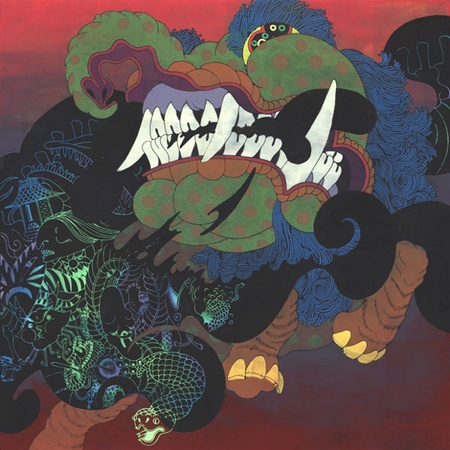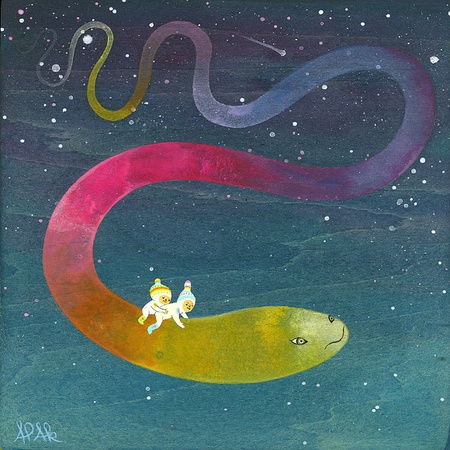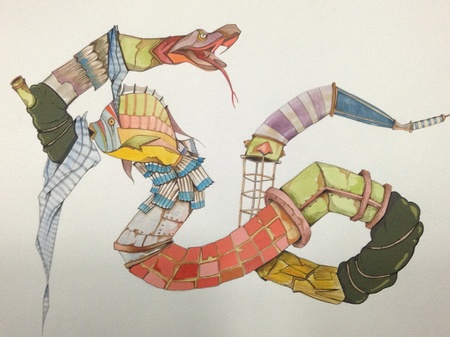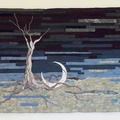Snakes get a bad rap in the West. In Christianity, the snake symbolizes temptation and the fall from grace, and in Greek mythology, the most famous snakes are the ones growing from the evil gorgon Medusa’s head. Widely viewed in the West as slippery, sneaky and deadly creatures, they are denigrated rather than celebrated. In Asia, they enjoy much more respect. In India, because they shed their skin as they grow, snakes—or naga—represent rebirth and are worshipped by Hindus as divine beings. In the Buddhist tradition, a snake king is believed to have protected the Buddha from a rainstorm, and this multi-headed cobra has been commemorated in many Buddha images from Thailand and Cambodia. In China and other rice-growing cultures, since snakes kill the mice that eat the rice crops, they are regarded as protectors of the food supply and symbols of prosperity. As such, the serpent has the honor of being the sixth of the twelve animals in the Chinese Lunar Calendar. 2013 is the Chinese Year of the Snake, and a number of local artists are celebrating this much maligned creature in their work.
Patricia Wakida, a fourth generation Japanese American writer and artist (recently transplanted here from the Bay Area) has long been fascinated by snakes and has for years kept pet corn snakes. “Ironically,” she laments, in “2011 we were a two snake household, and now we’re done to none.” Losing her beloved serpentine pets did not stop her from carving several linoleum prints of snakes in celebration of this year. In her nengajo, or traditional Japanese New Year’s card, two snakes intertwine and stare cheekily at each other, as if planning all sorts of mischief for the year. For the cover of her 2013 calendar, a printed homage to the seasons of both California and Japan, a single, slender corn snake winds through jaggedly patterned grass reminiscent of Japanese kimono fabric.
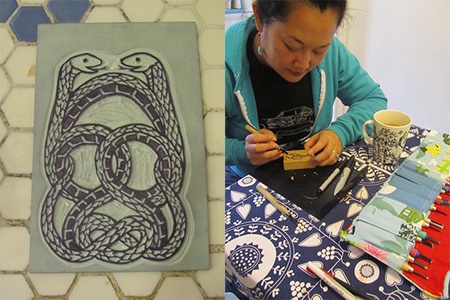
LEFT: Linoleum Block Carved with Two Snakes for New Year's Card by Patricia Wakida, 2012, RIGHT: Patricia Wakida carving Woodblocks, 2012.
Wakida’s prints of snakes, birds, flowers and fruit may have a distinct Japanese flavor, but its derivation is more convoluted than one would expect. She was strongly influenced by the work of renowned Bay-Area printmaker Henry Evans (1918-1990), whose botanical prints, with their flat color planes and absence of backgrounds, were themselves inspired by Japanese design. Evans used linoleum as a printing surface and an 1852 Washington Hand Press to make his botanical prints. Wakida’s prints have the appearance of traditional Japanese woodblock prints, but she printed her calendar on a Challenge proof press, made available to her while on a writing residency in Minnesota last summer. For her colors, however, the Japanese influence is direct, learned from printmaker Yoshiko Yamamoto of Arts and Crafts Press in Washington State. “I mix a little gray into my pigments, which gives the colors a Japanese tone.” A result of cross-cultural artistic breeding, Wakida’s sleek serpent, printed with a thick black outline and soft green, is more sinuous than sinister, more elegant than evil.
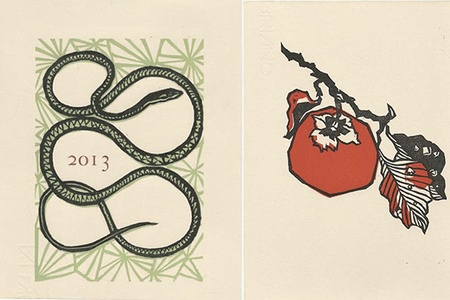
LEFT: Cover Image of a Snake for her 2013 Calendar, by Patricia Wakida, linoleum print on Fabriano cotton rag paper, 2012, RIGHT: Persimmon for October, 2013 Calendar, by Patricia Wakids, linoleum print on Fabriano cotton rag paper, 2012.
In celebration of the Chinese New Year, snakes of all imaginable characters have been assembled by Giant Robot until February 20th. Over 40 artists were invited to contribute their snakes to the Year of the Snake group exhibition on view at the GR2 gallery on Sawtelle until February 20, 2013. The works include the complex and dynamic work of New York-based Shawn Cheng, indie comicker and founder of the Partyka comics/art collective in Brookyln. His snake appears to be embroiled in a fierce battle with other mythical Asian creatures, perhaps all part of a bad dream that is being consumed by an elephantine Baku, a fantastic beast believed to devour nightmares.
At the other end of the spectrum are the super-cute snakes of San Diego-based illustrator Susie Ghahremani, who are portrayed in different comic guises, and the sweet fantasy imagery of art-duo APAK (Aaron and Ayumi Piland) from Portland, Oregon. In their painting, two of the curious little beings who typically inhabit their utopian realms ride through the night sky on the back of the most benign flying snake.
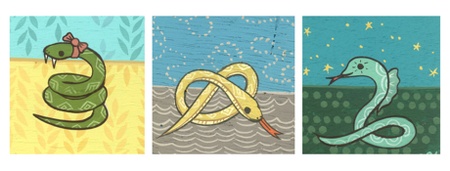
LEFT: Year of the Bowtie; CENTER: Year of the Pretzel; RIGHT: Year of the Nessie by Susie Ghahremani, gouache on wood, 2012-2013.
Not all the artists in the exhibition have Asian roots. Gosha Levochkin was born in Russia and now works from his studio in Silver Lake, Los Angeles. His thought-provoking drawings and watercolors often depict the complex and chaotic nature of the urban environment, and his snake also appears to be a product of this chaos. The exquisitely rendered creature is no longer fully a living beast, but a patchwork being pieced together out of metal, tile and many of the other synthetic materials out of which we build our living structures.
“We have assembled an amazing collection of artists to celebrate Year of the Snake,” says Eric Nakamura, Founder and Director of Giant Robot. “This is our 5th Lunar New Year show in a row now. It’s been one of the most popular exhibitions we do annually. The Snake is a cunning and wise animal, and this Snake show features some of our regular artists as well as lots of special guests. I do think it’s because of the New Year theme that some of the ‘well known’ artists participated, and for that, I’m thankful.”
Serpents all over our state may be thankful this year too. Such a rich array of artistic renderings of snakes may charm many Southern Californians into reconsider their feelings towards the “narrow fellow in the grass.”
Patricia Wakida’s work can be found on her website. Prints from her 2013 calendar will be on view throughout 2013 at the USC Medical School. She is also managing the Los Angeles Atlas Project, featured in the KCET story, Maps to Dreamers’ Homes: Los Angeles Geography and Image.
* * *
Year of the Snake
February 2 – 20, 2013
GR2
2062 Sawtelle Blvd
Los Angeles CA 90025
More information about Giant Robot and GR2’s Year of the Snake exhibition is available here.
* * *
* This article was originally written for the KCET Artbound “Asian Accents” series that explores the diverse range of artistic influences from Asia in the arts and culture of Southern California. It was originally published on February 5, 2013. Please visit the original article page and “Like” it!
© 2013 Meher McArthur / KCET


